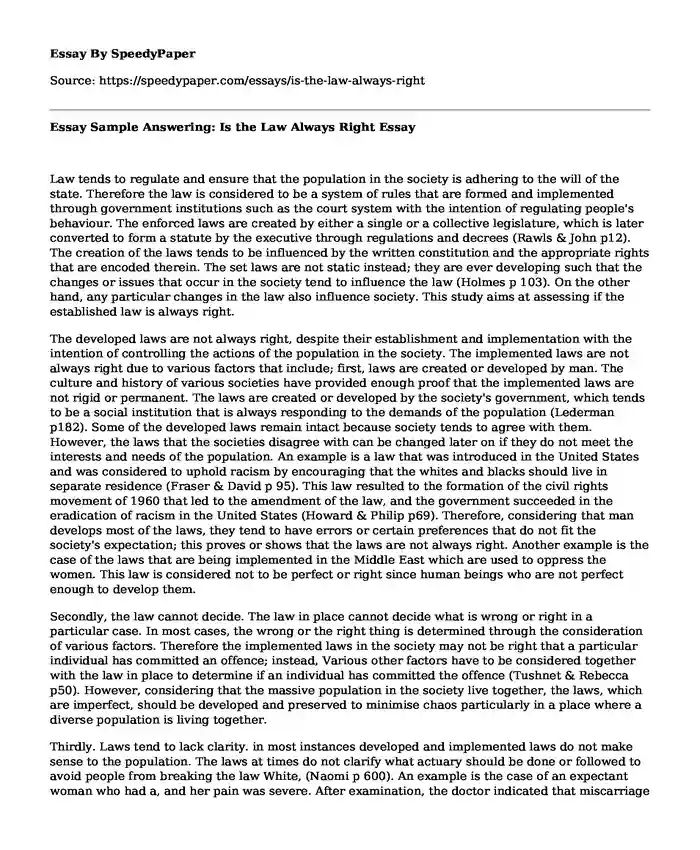Law tends to regulate and ensure that the population in the society is adhering to the will of the state. Therefore the law is considered to be a system of rules that are formed and implemented through government institutions such as the court system with the intention of regulating people's behaviour. The enforced laws are created by either a single or a collective legislature, which is later converted to form a statute by the executive through regulations and decrees (Rawls & John p12). The creation of the laws tends to be influenced by the written constitution and the appropriate rights that are encoded therein. The set laws are not static instead; they are ever developing such that the changes or issues that occur in the society tend to influence the law (Holmes p 103). On the other hand, any particular changes in the law also influence society. This study aims at assessing if the established law is always right.
The developed laws are not always right, despite their establishment and implementation with the intention of controlling the actions of the population in the society. The implemented laws are not always right due to various factors that include; first, laws are created or developed by man. The culture and history of various societies have provided enough proof that the implemented laws are not rigid or permanent. The laws are created or developed by the society's government, which tends to be a social institution that is always responding to the demands of the population (Lederman p182). Some of the developed laws remain intact because society tends to agree with them. However, the laws that the societies disagree with can be changed later on if they do not meet the interests and needs of the population. An example is a law that was introduced in the United States and was considered to uphold racism by encouraging that the whites and blacks should live in separate residence (Fraser & David p 95). This law resulted to the formation of the civil rights movement of 1960 that led to the amendment of the law, and the government succeeded in the eradication of racism in the United States (Howard & Philip p69). Therefore, considering that man develops most of the laws, they tend to have errors or certain preferences that do not fit the society's expectation; this proves or shows that the laws are not always right. Another example is the case of the laws that are being implemented in the Middle East which are used to oppress the women. This law is considered not to be perfect or right since human beings who are not perfect enough to develop them.
Secondly, the law cannot decide. The law in place cannot decide what is wrong or right in a particular case. In most cases, the wrong or the right thing is determined through the consideration of various factors. Therefore the implemented laws in the society may not be right that a particular individual has committed an offence; instead, Various other factors have to be considered together with the law in place to determine if an individual has committed the offence (Tushnet & Rebecca p50). However, considering that the massive population in the society live together, the laws, which are imperfect, should be developed and preserved to minimise chaos particularly in a place where a diverse population is living together.
Thirdly. Laws tend to lack clarity. in most instances developed and implemented laws do not make sense to the population. The laws at times do not clarify what actuary should be done or followed to avoid people from breaking the law White, (Naomi p 600). An example is the case of an expectant woman who had a, and her pain was severe. After examination, the doctor indicated that miscarriage was due to blood infection. However since the miscarriage baby still had a heartbeat and the doctor could not order for abortion since it was illegal. The law in place lacked clarity by indicating what should be done in case of a particular situation, and the law did not seem to follow the daily common sense.
Works cited
Lederman, Daniel, and Guido Porto. "The price is not always right: on the impacts of commodity prices on households (and countries)." The World Bank Research Observer 31.1 (2015): 168-197.
Fraser, David. Cricket and the law: the man in white is always right. Routledge, 2004.
Holmes Jr, Oliver Wendell. The path of the law. The Floating Press, 2009.
Howard, Philip K. The death of common sense: How the law is suffocating America. Random House, 2011.
Rawls, John. The law of peoples: with" The idea of public reason revisited". Harvard University Press, 2001.
Tushnet, Rebecca. "Why the Customer Isn't Always Right: Producer-Based Limits on Rights Accretion in Trademark." (2007).
White, Naomi Rosh. "'The customer is always right?': Student discourse about higher education in Australia." Higher Education 54.4 (2007): 593-604.
Cite this page
Essay Sample Answering: Is the Law Always Right. (2022, Oct 20). Retrieved from https://speedypaper.com/essays/is-the-law-always-right
Request Removal
If you are the original author of this essay and no longer wish to have it published on the SpeedyPaper website, please click below to request its removal:
- Essay Sample on Skepticism in Early Modern Europe
- Military Motivation Essay, Free Example for You
- Concept Proposal Essay Example: Vancouver Sports Hotel
- Essay Samples: Religion and Homosexuality, Gender and Health
- HRM Essay Example: Benefit Packages, Safety and Health Concerns
- Essay Sample on Benefits of Microcirculation
- Essay Sample on Employee Recognition, Appreciation, and Praise
Popular categories





